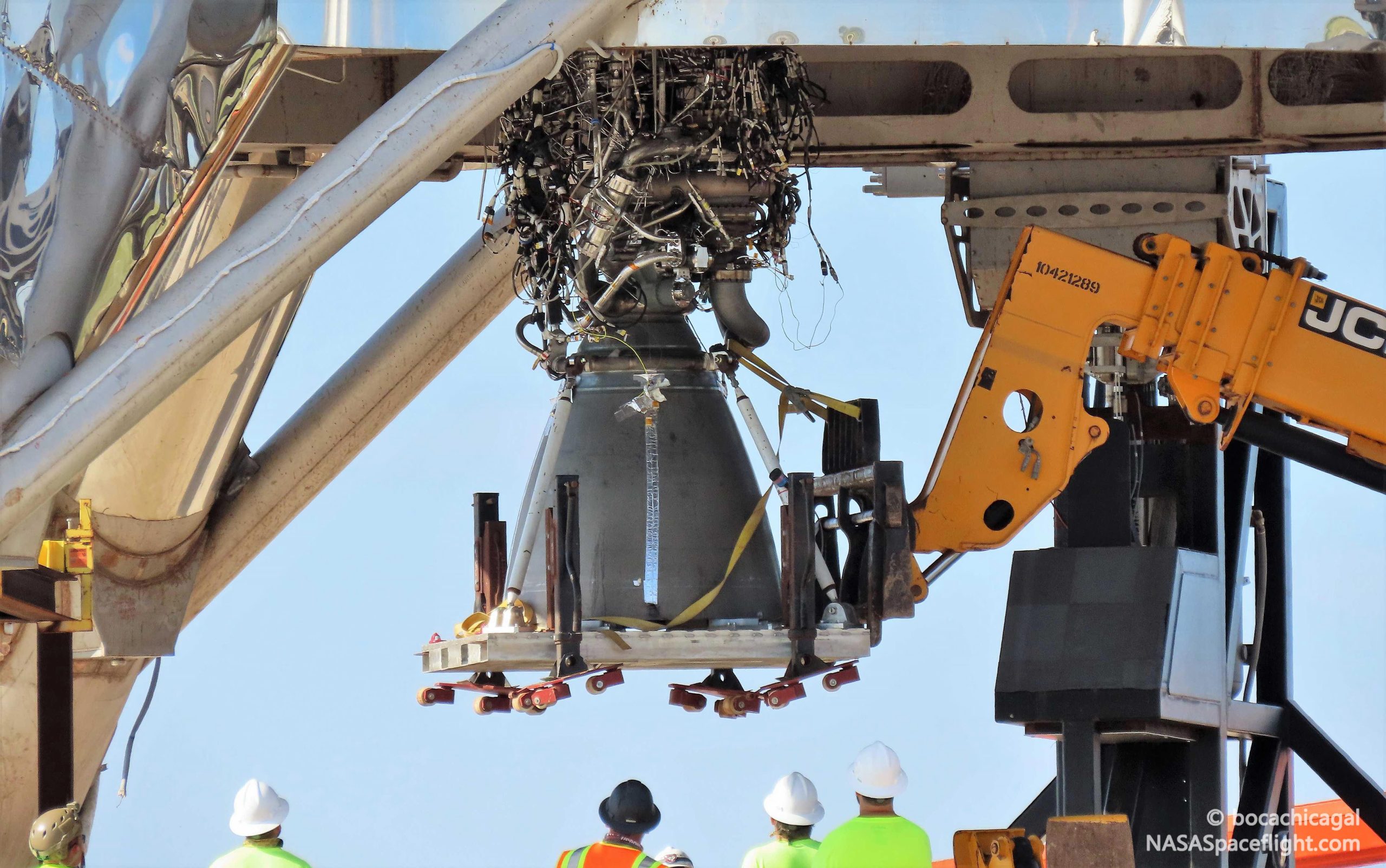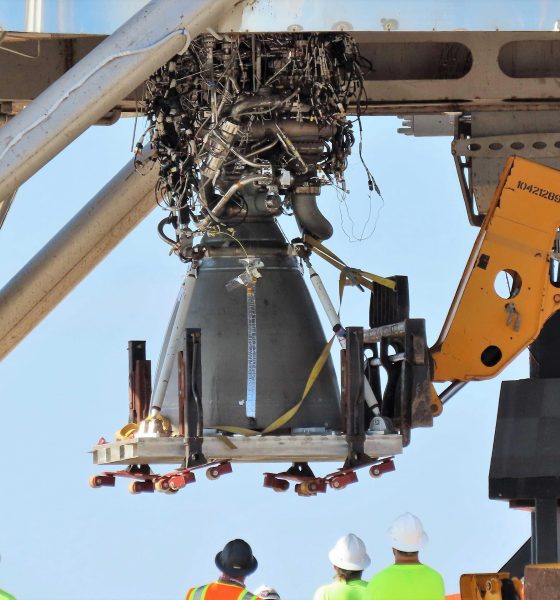

News
SpaceX ships Raptor to Texas for first Starhopper hover tests after fixing vibration bugs
After a brisk week of no fewer than three lengthy static fire tests, SpaceX has effectively confirmed that a critical vibration-related fault was solved, delivering the company’s latest completed Raptor engine to Boca Chica, Texas earlier today.
SpaceX technicians are now in the process of installing the engine – believed to be Raptor SN06 – on Starhopper, a low-fidelity prototype meant to act as a sort of flying testbed for Starship technologies and a mobile test stand for Raptor test fires. According to SpaceX CEO Elon Musk, if Raptor SN06 is installed, successfully checks out, and supports Starhopper’s first untethered hover test within the next 3-7 days, he will deliver an updated presentation on SpaceX’s Starhip/Super Heavy launch vehicle and (hopefully) the company’s plans for the Moon and Mars around the end of July.
This Raptor is the third to be installed on Starhopper. The first engine (SN02) was installed in March 2019 and became the first Raptor to ignite as part of a vehicle meant to eventually fly. During a duo of more or less successful test fires, Starhopper strained against its tethers, lifting a few inches off the ground. Although it did technically mark Starhopper’s inaugural hop, Raptor SN02 also suffered damage during the tests that demanded its removal.
As recently noted by observant fans after Musk revealed that SpaceX had been dealing with a “600 Hz” vibration issue, the horn-like noise during shutdown actually happens to be in the 600 Hz range, with an additional spike at 300 Hz a likely sign of an issue with acoustic and/or mechanical resonance. With SN06, SpaceX engineers and test/production technicians have managed to rapidly implement a fix for that undesirable resonance, powering through several successful static fires with durations as high as 80+ seconds, approaching the propellant storage limits of SpaceX’s McGregor test facilities.
Raptor SN04?
Shortly after its static fire tests in Boca Chica, Raptor SN02 was removed. According to a source familiar with the test process, the engine was brought up to McGregor, TX and repaired before SpaceX technicians – urged by CEO Elon Musk – effectively ran the engine until it failed catastrophically. Some two months after its removal (early June), a new Raptor engine – this time believed to be Raptor SN04, effectively an inert test article – was installed on Starhopper for a handful of days.
SN04 was exclusively used to check fitment and verify Raptor’s thrust vector control (TVC) gumball capabilities – quite successfully, by all appearances. A few days after installation, it was removed and shipped elsewhere. Subsequently, Raptor SN05 was tested in McGregor with the hopes that it would be able to support the first Starhopper hover tests, but the vibration issue described by Musk caused damage or at least killed confidence that the engine (a single point of failure on Starhopper) was reliable enough to support hover tests.
Raptor SN06 thus entered our story, arriving at McGregor around July 4th. SpaceX’s world-class team of engineers and technicians demonstrated their famous speed and agility, firing up SN06 less than 24 hours after its arrival. This initial test showed nothing out of order and was followed by no less than 3-4 30-80-second static fire tests, all of which were more or less successful. Per Musk, things were looking good as of July 8th, and Raptor’s July 11th arrival at Boca Chica is a foolproof confirmation that the engine is healthy and ready for the Raptor family’s first true flight.

Stay tuned for coverage of SpaceX’s imminent Starhopper static fire and hover test campaign.
Check out Teslarati’s Marketplace! We offer Tesla accessories, including for the Tesla Cybertruck and Tesla Model 3.

News
Tesla is not sparing any expense in ensuring the Cybercab is safe
Images shared by the longtime watcher showed 16 Cybercab prototypes parked near Giga Texas’ dedicated crash test facility.

The Tesla Cybercab could very well be the safest taxi on the road when it is released and deployed for public use. This was, at least, hinted at by the intensive safety tests that Tesla seems to be putting the autonomous two-seater through at its Giga Texas crash test facility.
Intensive crash tests
As per recent images from longtime Giga Texas watcher and drone operator Joe Tegtmeyer, Tesla seems to be very busy crash testing Cybercab units. Images shared by the longtime watcher showed 16 Cybercab prototypes parked near Giga Texas’ dedicated crash test facility just before the holidays.
Tegtmeyer’s aerial photos showed the prototypes clustered outside the factory’s testing building. Some uncovered Cybercabs showed notable damage and one even had its airbags engaged. With Cybercab production expected to start in about 130 days, it appears that Tesla is very busy ensuring that its autonomous two-seater ends up becoming the safest taxi on public roads.
Prioritizing safety
With no human driver controls, the Cybercab demands exceptional active and passive safety systems to protect occupants in any scenario. Considering Tesla’s reputation, it is then understandable that the company seems to be sparing no expense in ensuring that the Cybercab is as safe as possible.
Tesla’s focus on safety was recently highlighted when the Cybertruck achieved a Top Safety Pick+ rating from the Insurance Institute for Highway Safety (IIHS). This was a notable victory for the Cybertruck as critics have long claimed that the vehicle will be one of, if not the, most unsafe truck on the road due to its appearance. The vehicle’s Top Safety Pick+ rating, if any, simply proved that Tesla never neglects to make its cars as safe as possible, and that definitely includes the Cybercab.
Elon Musk
Tesla’s Elon Musk gives timeframe for FSD’s release in UAE
Provided that Musk’s timeframe proves accurate, FSD would be able to start saturating the Middle East, starting with the UAE, next year.

Tesla CEO Elon Musk stated on Monday that Full Self-Driving (Supervised) could launch in the United Arab Emirates (UAE) as soon as January 2026.
Provided that Musk’s timeframe proves accurate, FSD would be able to start saturating the Middle East, starting with the UAE, next year.
Musk’s estimate
In a post on X, UAE-based political analyst Ahmed Sharif Al Amiri asked Musk when FSD would arrive in the country, quoting an earlier post where the CEO encouraged users to try out FSD for themselves. Musk responded directly to the analyst’s inquiry.
“Hopefully, next month,” Musk wrote. The exchange attracted a lot of attention, with numerous X users sharing their excitement at the idea of FSD being brought to a new country. FSD (Supervised), after all, would likely allow hands-off highway driving, urban navigation, and parking under driver oversight in traffic-heavy cities such as Dubai and Abu Dhabi.
Musk’s comments about FSD’s arrival in the UAE were posted following his visit to the Middle Eastern country. Over the weekend, images were shared online of Musk meeting with UAE Defense Minister, Deputy Prime Minister, and Dubai Crown Prince HH Sheikh Hamdan bin Mohammed. Musk also posted a supportive message about the country, posting “UAE rocks!” on X.
FSD recognition
FSD has been getting quite a lot of support from foreign media outlets. FSD (Supervised) earned high marks from Germany’s largest car magazine, Auto Bild, during a test in Berlin’s challenging urban environment. The demonstration highlighted the system’s ability to handle dense traffic, construction sites, pedestrian crossings, and narrow streets with smooth, confident decision-making.
Journalist Robin Hornig was particularly struck by FSD’s superior perception and tireless attention, stating: “Tesla FSD Supervised sees more than I do. It doesn’t get distracted and never gets tired. I like to think I’m a good driver, but I can’t match this system’s all-around vision. It’s at its best when both work together: my experience and the Tesla’s constant attention.” Only one intervention was needed when the system misread a route, showcasing its maturity while relying on vision-only sensors and over-the-air learning.
News
Tesla quietly flexes FSD’s reliability amid Waymo blackout in San Francisco
“Tesla Robotaxis were unaffected by the SF power outage,” Musk wrote in his post.

Tesla highlighted its Full Self-Driving (Supervised) system’s robustness this week by sharing dashcam footage of a vehicle in FSD navigating pitch-black San Francisco streets during the city’s widespread power outage.
While Waymo’s robotaxis stalled and caused traffic jams, Tesla’s vision-only approach kept operating seamlessly without remote intervention. Elon Musk amplified the clip, highlighting the contrast between the two systems.
Tesla FSD handles total darkness
The @Tesla_AI account posted a video from a Model Y operating on FSD during San Francisco’s blackout. As could be seen in the video, streetlights, traffic signals, and surrounding illumination were completely out, but the vehicle drove confidently and cautiously, just like a proficient human driver.
Musk reposted the clip, adding context to reports of Waymo vehicles struggling in the same conditions. “Tesla Robotaxis were unaffected by the SF power outage,” Musk wrote in his post.
Musk and the Tesla AI team’s posts highlight the idea that FSD operates a lot like any experienced human driver. Since the system does not rely on a variety of sensors and a complicated symphony of factors, vehicles could technically navigate challenging circumstances as they emerge. This definitely seemed to be the case in San Francisco.
Waymo’s blackout struggles
Waymo faced scrutiny after multiple self-driving Jaguar I-PACE taxis stopped functioning during the blackout, blocking lanes, causing traffic jams, and requiring manual retrieval. Videos shared during the power outage showed fleets of Waymo vehicles just stopping in the middle of the road, seemingly confused about what to do when the lights go out.
In a comment, Waymo stated that its vehicles treat nonfunctional signals as four-way stops, but “the sheer scale of the outage led to instances where vehicles remained stationary longer than usual to confirm the state of the affected intersections. This contributed to traffic friction during the height of the congestion.”
A company spokesperson also shared some thoughts about the incidents. “Yesterday’s power outage was a widespread event that caused gridlock across San Francisco, with non-functioning traffic signals and transit disruptions. While the failure of the utility infrastructure was significant, we are committed to ensuring our technology adjusts to traffic flow during such events,” the Waymo spokesperson stated, adding that it is “focused on rapidly integrating the lessons learned from this event, and are committed to earning and maintaining the trust of the communities we serve every day.”








